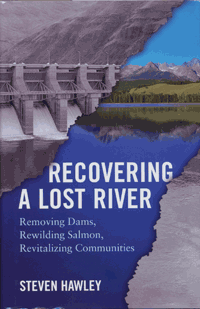The issue of removing dams from rivers in the western United States makes good scientific, economic and environmental sense, according to author Steven Hawley. Hawley's new book, "Recovering A Lost River: Removing Dams, Rewilding Salmon, Revitalizing Communities" is a comprehensive and fascinating argument on why dams should be removed and how in the Northwest dam removal projects are at work—and working well.
Hawley will give a free lecture and will sign books at the Community Library in Ketchum tonight, May 18, at 6 p.m. Hawley's forum is sponsored by the nonprofit group Idaho Rivers United and the Community Library. Iconoclast Books in Ketchum will have books for sale at the presentation.
"A third of freshwater species are threatened or endangered," Hawley reported. "Forty percent of freshwater bodies in America are too polluted for swimming or fishing. Half the nation's wetlands are gone."
"Recovering A Lost River" presents a specific overview on the battle of removing four large dams in eastern Washington state along the lower Snake River, which is part of the Columbia River basin of the Pacific Northwest. The Snake River is the largest tributary of the Columbia River.
"In the Columbia River basin, the Snake River used to produce half of all the spring and summer chinook salmon," said Greg Stahl, assistant policy director of Idaho Rivers United. "In that universe of the salmon-rich tributaries, the Salmon River alone produced 39 percent of all the spring and summer chinook in the entire Columbia Basin."
Stahl said what is unique about the big picture of dams that Hawley writes about is how unique Idaho salmon and steelhead are.
"The salmon that return to the Sawtooth Valley are the Olympic champions of the salmon universe," he said. "They swim higher and farther than any other salmon on the planet. They are integral part of an ecosystem. Marine nutrients are in the trees in the Sawtooth Valley. They are a keystone species because they are at the center of so much life."
Stahl said fish populations plummeted when dams were built on the lower Snake River between 1961 and 1975.
"In 1986, Idaho's coho salmon were declared extinct, in 1981 sockeye salmon were listed as endangered species, in 1992 chinook salmon were listed as threatened and in 1997 Idaho's steelhead were listed as threatened," he said. "Historically, Idaho witnessed returns of 2.5 or more millions salmon. Today, populations are about 2 percent of 2.5 millions—dams go up, fish go down."
Sabina Dana Plasse: splasse@mtexpress.com


 “Recovering A Lost River: Removing Dams, Rewilding Salmon, Revitalizing Communities” by Steven Hawley. Beacon Press. $26.95. 252 pp.
“Recovering A Lost River: Removing Dams, Rewilding Salmon, Revitalizing Communities” by Steven Hawley. Beacon Press. $26.95. 252 pp.



































